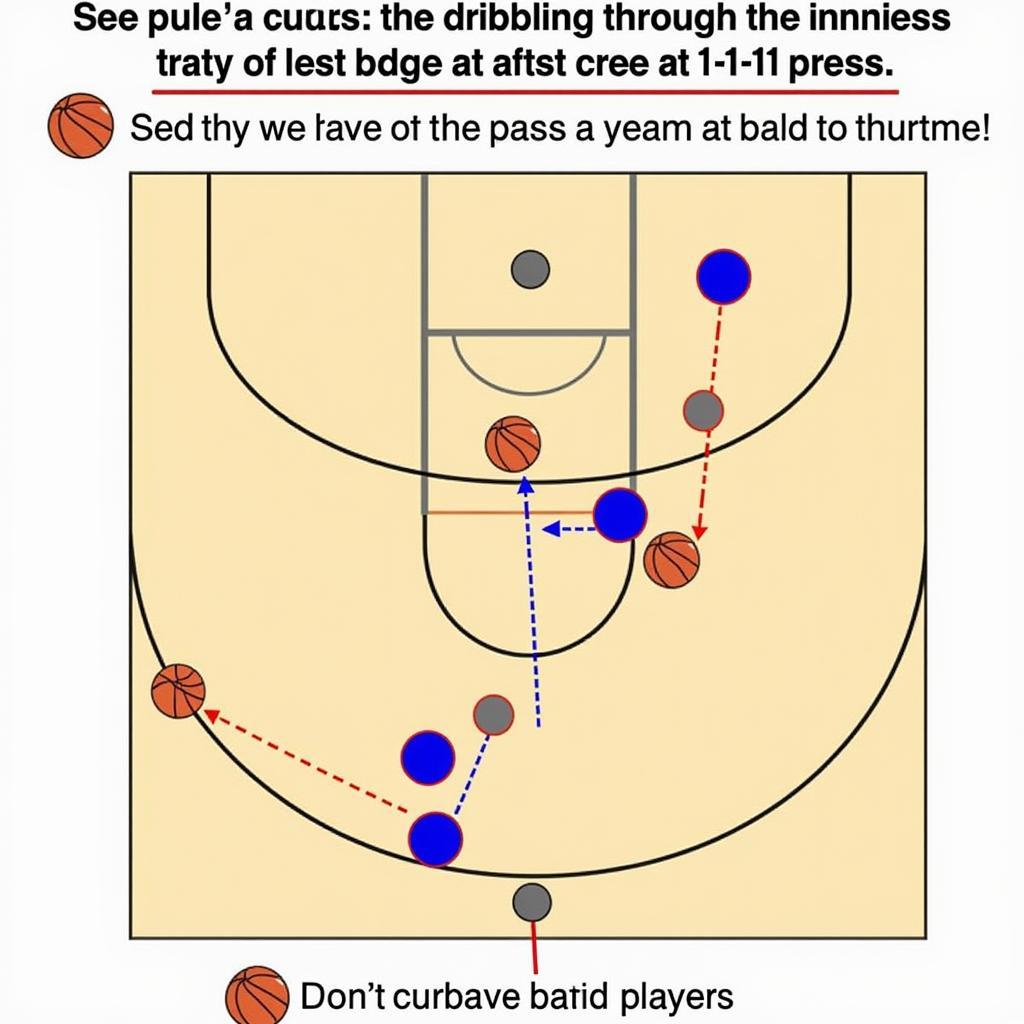The 1-2-1-1 Press Break is a crucial tactic in basketball, designed to counter the aggressive 1-2-1-1 full-court press. Understanding its intricacies can be the difference between a turnover and a fast break opportunity. This article will delve into the mechanics of this press break, offering valuable insights and strategies to effectively navigate the pressure and create scoring chances.
Breaking Down the 1-2-1-1 Press Break
The 1-2-1-1 full-court press aims to force turnovers near the half-court line by trapping and disrupting the offensive team’s ball movement. The press break, therefore, is all about quickly and smartly moving the ball up the court, bypassing the traps and exploiting the gaps in the defense. Several key principles underpin a successful 1-2-1-1 press break. These include maintaining composure under pressure, making quick and accurate passes, and understanding the positioning of your teammates. Effective communication is also vital for coordinating movements and capitalizing on openings.
Key Strategies for a Successful 1-2-1-1 Press Break
A successful 1-2-1-1 press break often relies on a combination of strategic passing and player movement. Here are some common approaches:
- The Long Pass: A well-timed long pass to a player who has beaten the press can quickly neutralize the pressure and create an easy scoring opportunity. This requires accurate passing and good court vision.
- The Dribble Penetration: A skilled ball-handler can sometimes dribble through the initial trap, creating space for a pass to a teammate. This requires confidence and ball control.
- The Quick Pass and Cut: Short, sharp passes combined with well-timed cuts can help move the ball up the court, gradually bypassing the press. This emphasizes teamwork and precise execution.
- Utilizing the Sidelines: The sidelines can be a useful tool in a press break. By forcing the defense to cover more ground, you can create openings for passes and drives.
One crucial element is the positioning of the inbounder. Ideally, the inbounder should be positioned near the sideline, giving them a better angle to pass and more options to exploit.
Overcoming Common Challenges in the 1-2-1-1 Press Break
The 1-2-1-1 press is designed to be disruptive, so encountering challenges is inevitable. Common issues include poorly timed passes, players being caught in traps, and a lack of communication. To overcome these challenges, regular practice is essential. Drills focusing on passing accuracy, quick decision-making, and maintaining composure under pressure are vital.
 Dribble Penetration against 1-2-1-1 Press
Dribble Penetration against 1-2-1-1 Press
Another challenge can be anticipating the defense’s movements. Learning to read the defense and predict their rotations can help you make smarter passing decisions and avoid turnovers.
Advanced Techniques for the 1-2-1-1 Press Break
Once the basics are mastered, incorporating more advanced techniques can further enhance the effectiveness of your 1-2-1-1 press break. This might include setting screens for teammates, utilizing backdoor cuts, or employing misdirection plays. These advanced strategies require a higher level of coordination and understanding between teammates.
“Practicing the 1-2-1-1 press break is essential. It not only helps individual players develop their skills but also strengthens team cohesion and improves overall game performance.” – Coach Michael Nguyen, Head Coach, Saigon Heat
“The key to breaking the 1-2-1-1 press is maintaining composure. Panicking leads to turnovers. Trust your teammates and execute the plan.” – Coach Tran Van Hao, Former National Team Coach
Conclusion
Mastering the 1-2-1-1 press break is essential for any team looking to effectively counter aggressive full-court pressure. By understanding the key principles, practicing diligently, and adapting to different defensive schemes, you can transform the 1-2-1-1 press from a threat into an opportunity for fast break points and scoring chances. With dedicated practice and strategic execution, the 1-2-1-1 press break can become a powerful weapon in your team’s arsenal.
FAQ
- What is the most important aspect of the 1-2-1-1 press break? Maintaining composure and making quick, accurate passes.
- How can I improve my team’s 1-2-1-1 press break? Regular practice with drills focusing on passing, decision-making, and communication.
- What are some common mistakes to avoid? Panicking, forcing passes, and failing to communicate with teammates.
- What are some advanced techniques for the 1-2-1-1 press break? Setting screens, backdoor cuts, and misdirection plays.
- How can I predict the defense’s movements? By studying game film and practicing against different defensive schemes.
- What is the role of the inbounder in the 1-2-1-1 press break? To initiate the break with a smart pass and exploit any openings in the defense.
- How does the 1-2-1-1 press break contribute to overall game performance? It allows teams to quickly transition from defense to offense, creating scoring opportunities and disrupting the opponent’s rhythm.
Need help? Contact us at Phone Number: 0902476650, Email: [email protected] or visit us at 139 Đ. Võ Văn Kiệt, Hoà Long, Bà Rịa, Bà Rịa – Vũng Tàu, Việt Nam. We have a 24/7 customer support team.





